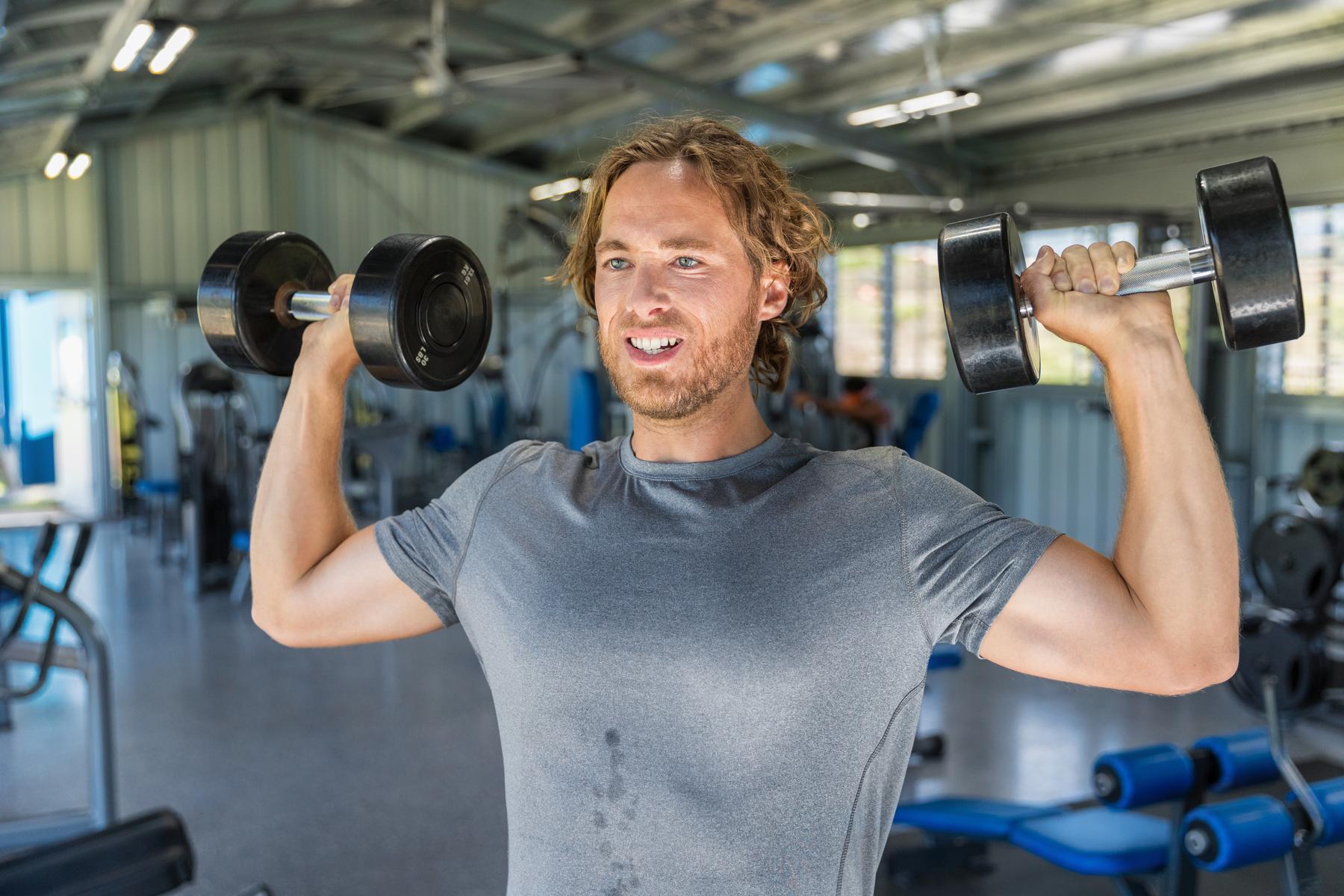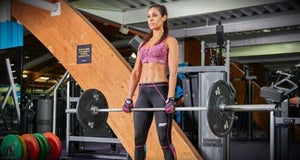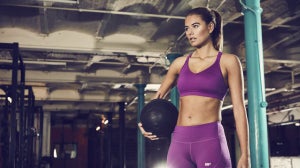Chris Appleton
Author & Editor2 years ago

Deltoids are one of the most frequently used muscle groups when it comes to training for both strength and hypertrophy; having strong deltoids helps when performing pressing movements such as the bench press, military press, and of course the shoulder press.This article will explain the differences between the dumbbell and barbell variations of the shoulder press and tell you why you should consider incorporating them into your shoulder routine.
What is a Shoulder Press?
The overhead press also referred to as a shoulder press, military press, is a weight training exercise with many variations that primarily hits the deltoids. It is typically performed while either standing or sitting and sometimes even when squatting, in which a weight is pressed straight upwards from the rack position until the arms are locked out overhead, while the legs, lower back, and abs maintain balance. The exercise helps build bigger and stronger shoulders and can help build the arms too.Which muscles does the Shoulder Press work?
Your deltoids are formed of 3 heads:- Lateral (medial)
- Anterior (front)
- Posterior (behind)
How to do a Dumbbell Shoulder Press
When using dumbbells for the shoulder press you’re able to go through a slightly longer range of motion because the dumbbells are able to come down in line with your head on each side.However, the weight you’re able to handle will be slightly less compared to using a barbell due to the necessity of good balance throughout the movement in order to guide the dumbbells through a correct range of motion.Seated or standing
The shoulder press can be done while in a standing or seated position. Being seated offers more support for the body whereas standing requires more stability support from the legs and core. Standing does have more benefits however if you need the support after an injury or due to weaker areas, the seated version will be more beneficial.Technique
- Position yourself on a vertical bench with a pair of dumbbells by your feet.
- Use a partner to help place the dumbbells in position above your head, or pick the dumbbells up off the floor by deadlifting them onto your knees and then bring them up to your start-pressing position by flicking them up off your knees one at a time.
- Start from the top of the movement with your arms straight but without your elbows locked out.
- Control the weight down for the eccentric portion of the movement until your arm breaks parallel with the ground (the dumbbells should be in line with your head on either side).
- Pause for a second at the bottom of the movement and press upwards to perform the concentric contraction (the dumbbells should become closer as you continue to press above your head).
- Once you reach the top of the movement continue to perform the rest of the reps within the set.
- The dumbbells shouldn’t touch at the top of the movement.
- You should also remember not to lock out your elbows.
- Try creating a slight arch in your lower back and bringing your chest up and out to aid your range of motion.
How to do a Barbell Shoulder Press
Shoulder pressing with a barbell will allow you to use more weight and requires slightly less emphasis on balance, as well as a lesser range of motion. The barbell shoulder press is one of the main compound movements used by professional bodybuilders as it allows you to handle more weight than the dumbbell variant.When performing this variation of the shoulder press, you’ll still be able to bring the barbell in front of your head. Your technique needs to be perfect to reduce your risk of injury or performing the exercise incorrectly. This will require good upper-body mobility.
Technique
- Start by sitting on the bench with back support and a rack for the barbell.
- Hold the bar with a 90°angle at your elbow.
- Either using a training partner or if on your own, lift the bar above your head; this will be your starting position.
- Take a deep breath.
- Control the barbell down on the eccentric portion of the movement in front of you until it reaches just above your collarbone.
- Exhale and press upwards from this position until the barbell ends up back at the starting point.
- Do not lock out the elbows; continue the exercise for your desired amount of repetitions.
Tip: Try creating a slight arch in your lower back and bringing your chest up and out to aid your range of motion
Common Shoulder Press mistakes
Skipping the warm-up
you’re working a static job, avoiding the warm-up can cause some discomfort or even injury. To be quite honest, warming up in general is recommended in order to prepare the body for one of the bigger compound movements in the lifting manual.Try some thoracic extensions, windmills or swimmers hugs to get warm.Hyperextending the wrists
Hold the bar in the palm and wrap the hand around to secure it. Keep the wrist and palm in line to offer the best support and avoid hyperextension.Keep the elbows in
You may be tempted in a front rack to let the elbows flare out. Keep them at about 30 degrees from the body for better strength and mobility.Arching the backKeep the core engaged and back straight. Arching will only put a heavy weight overload on your back which will be in an awkward position. That’s the last thing we want.Shoulder Press Variations
Arnold Press
Hold a dumbbell in each hand with your arm bent, replicating the top of a biceps curl, so your palms are facing inwards. Rather than pushing straight up, spread your arms to each side laterally, then press your arms up and twist your hands so your palms face forwards.
Z Press
First, create a strong base to press from on the floor by sitting with straight legs, an upright torso, with your heels dug into the floor. Brace your core and legs before pressing the weight upwards. Lockout and Descend.Kettlebell Press
Start with the kettlebell in the rack position. Make sure your elbow is tucked into your chest. Then press the weight directly up overhead. Lower the weight by lowering the bell and repeat the move.Shoulder Press: Your Questions Answered
What are the benefits of the shoulder press?
The shoulder press is one of the big compound lifts and, if done correctly, will improve the strength and size of not only your shoulders, but your triceps, trapezius and core muscles that will be used to stabilize the body.Is the shoulder press bad for you?
The answer depends on your technique. Do this move correctly with the right form and without overloading the weight too much, this can only be of benefit to you.Is it better to shoulder press whilst standing or sitting?
If you need support due to injury or weak core/back muscles, take the opportunity to do this seated until you are in a stronger position to do it standing. Standing does have more benefits though and if done correctly, will hit more muscles of the body.Take home message
Try incorporating these exercises into your routine if you’re looking to increase the size and strength of your shoulders!For hypertrophy stick to rep ranges between 6 and 15.For strength stick to rep ranges below 5!Our articles should be used for informational and educational purposes only and are not intended to be taken as medical advice. If you're concerned, consult a health professional before taking dietary supplements or introducing any major changes to your diet.
Chris Appleton
Author & Editor

Chris is an editor and a level 3 qualified Personal Trainer, with a BA honours degree in Sports Coaching and Development, and a level 3 qualification in Sports Nutrition.
He has experience providing fitness classes and programs for beginners and advanced levels of clients and sports athletes.
Chris is also a qualified football coach, delivering high-level goalkeeping and fitness training at a semi-professional level, with nutritional advice to help maintain optimal performance.
His experience in the sports and fitness industry spans 15 years and is continuously looking to improve.
In his spare time, Chris likes to dedicate it to his family while training in the gym.








